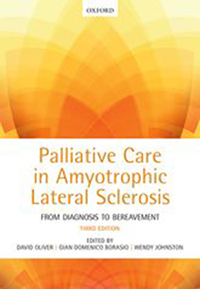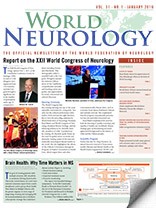Ed. David Oliver, Gian Domenico, Wendy Johnston
New York: Oxford University Press
326 Pages, with index
By Colin Quinn, MD
 “Nothing we can do.” This is a commonly used phrase when discussing the management of amyotrophic lateral sclerosis with recently diagnosed patients. It is often uttered at a time when patients are at their most vulnerable. They have just discovered they have a relentlessly progressive neurodegenerative disease and simultaneously they are left with the impression that they are on their own because there is “nothing we can do.”
“Nothing we can do.” This is a commonly used phrase when discussing the management of amyotrophic lateral sclerosis with recently diagnosed patients. It is often uttered at a time when patients are at their most vulnerable. They have just discovered they have a relentlessly progressive neurodegenerative disease and simultaneously they are left with the impression that they are on their own because there is “nothing we can do.”
In more than 20 concise and thoughtful chapters, Palliative Care in Amyotrophic Lateral Sclerosis provides an excellent guide for clinicians and patients regarding the particular needs of patients with ALS and their families, from diagnosis to death.
For many patients, the journey with ALS begins at diagnosis, and this is the focus of the opening chapter. As there is not yet a distinct biomarker for ALS, exclusion of other conditions is a critical part of the diagnostic approach, and is well described here. Up-to-date information regarding new genes associated with ALS and new understandings of the pathology behind ALS are briefly discussed.
The chapters which immediately follow include an honest and data-driven discussion covering both the purpose and challenges in delivering palliative care to ALS patients and an approach to breaking the news of an ALS diagnosis.
The subsequent chapters are devoted to a wide range of specific issues regarding the needs of patients, from frontotemporal dementia to frozen shoulder. All chapters provide clinically relevant information (“90% [of patients with ALS] are able to die peacefully”) and detailed descriptions of the variety of approaches to deal with the problems facing this patient population. The tone is nonjudgemental and inclusive of a variety of points of view, particularly regarding physician-assisted suicide and complementary and alternative medicines.
The chapters are written by authors with a depth and breadth of experiences on particular topics. This is demonstrated by a clear understanding of the variety of challenges facing patients and the pros and pitfalls of interventions. One minor criticism of this multiple-author approach is that there is often overlap between chapters and, at times, this means that the information in one portion of the book maybe somewhat inconsistent or incomplete when compared to another section. For example. in Chapter 7 (Control of Symptoms: Dysphagia), scopolamine is the first medication listed as a potential intervention for sialorrhea, however in Chapter 9 (Pain, Psychological distress and Other Symptoms), scopolamine is not mentioned at all.
This one minor critique aside, this should be required reading for anyone involved in the management of patients with this ALS. While there may be no cure for this disease, there is a great deal we can do.
